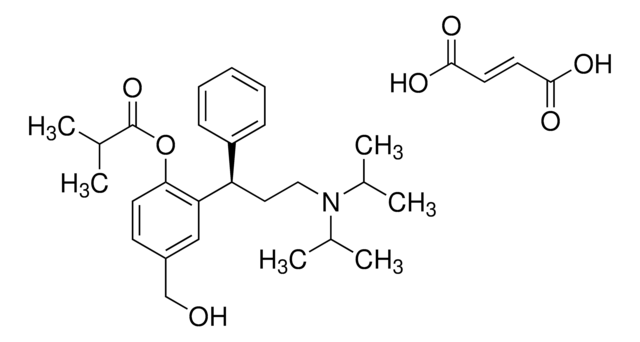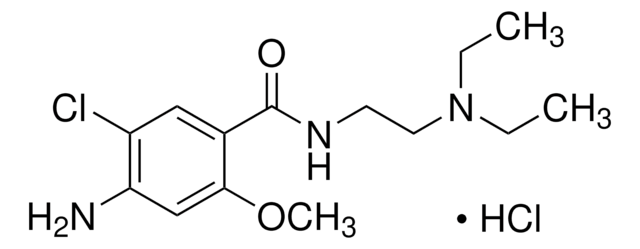SML1102
Darifenacin hydrobromide
≥98% (HPLC)
Sinônimo(s):
(3S)-1-[2-(2,3-Dihydro-5-benzofuranyl)ethyl]-α,α-diphenyl-3-pyrrolidineacetamide hydrobromide, UK 88525-04
About This Item
Produtos recomendados
Ensaio
≥98% (HPLC)
forma
powder
atividade óptica
[α]/D +41 to +49°, c = 1 in methylene chloride
condição de armazenamento
desiccated
cor
white to beige
solubilidade
DMSO: 20 mg/mL, clear
temperatura de armazenamento
−20°C
cadeia de caracteres SMILES
O=C(N)C([C@H]1CN(CCC2=CC=C(OCC3)C3=C2)CC1)(C4=CC=CC=C4)C5=CC=CC=C5.Br
InChI
1S/C28H30N2O2.BrH/c29-27(31)28(23-7-3-1-4-8-23,24-9-5-2-6-10-24)25-14-17-30(20-25)16-13-21-11-12-26-22(19-21)15-18-32-26;/h1-12,19,25H,13-18,20H2,(H2,29,31);1H/t25-;/m1./s1
chave InChI
UQAVIASOPREUIT-VQIWEWKSSA-N
Informações sobre genes
human ... CHRM2(1129) , CHRM3(1131)
Procurando produtos similares? Visita Guia de comparação de produtos
Descrição geral
Aplicação
Ações bioquímicas/fisiológicas
Características e benefícios
Palavra indicadora
Warning
Frases de perigo
Declarações de precaução
Classificações de perigo
Eye Irrit. 2 - Skin Irrit. 2 - STOT SE 3
Órgãos-alvo
Respiratory system
Código de classe de armazenamento
11 - Combustible Solids
Classe de risco de água (WGK)
WGK 3
Ponto de fulgor (°F)
Not applicable
Ponto de fulgor (°C)
Not applicable
Certificados de análise (COA)
Busque Certificados de análise (COA) digitando o Número do Lote do produto. Os números de lote e remessa podem ser encontrados no rótulo de um produto após a palavra “Lot” ou “Batch”.
Já possui este produto?
Encontre a documentação dos produtos que você adquiriu recentemente na biblioteca de documentos.
Conteúdo relacionado
DISCOVER Bioactive Small Molecules for Neuroscience
Nossa equipe de cientistas tem experiência em todas as áreas de pesquisa, incluindo Life Sciences, ciência de materiais, síntese química, cromatografia, química analítica e muitas outras.
Entre em contato com a assistência técnica









